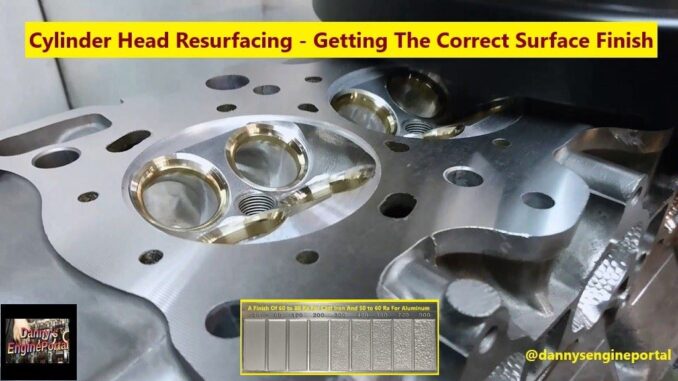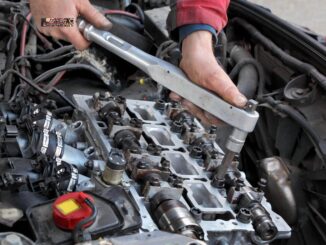
Cylinder head resurfacing is a very common process today, especially with all the leaking head gaskets.
Above all, cylinder head resurfacing is the most common machining operation, done in machine shops to date.
However, many different material combinations like aluminum, cast iron, and steel, all require their own specific surface finish.
So, there are many other reasons for cylinder head resurfacing, besides a head gasket leak:
- To restore flatness or to just improve the current surface finish.
- After welds or other repairs, or milled to increase the compression ratio.
- The angle changed slightly to better align, with an different intake manifold.
- After removing the cylinder head, for a valve job.
So, whatever the reason is for cylinder head resurfacing, you want to do it quickly, efficiently and correctly. Mistakes here can be very expensive, because once metal has been removed there is no putting it back.
To seal properly, a head gasket requires a surface finish, that is within a suggested range.
The specs vary, depending on the type of head gasket. And, if the surface is too rough, or in some cases too smooth, the gasket may not seal properly. So, look up the suggested specs, for a particular engine and/or a particular type of head gasket.
(CBN) or (PCD) Tool Bits, Can Give The Best Ra Numbers, But:
- You have to make sure you use, the correct feed rate and speed.
- The equipment has to be rigid enough, to hold the cutter steady.
- This is so the tool bit, does not lift or chatter, when it makes in interrupted cut.
That’s why, many machine shops today, have switched to dry milling for cylinder head resurfacing.
This is because, it eliminates the mess and maintenance, that goes with wet grinding.
How To Get The Correct Surface Finish
Today, you need smoother finishes required by many of today’s, aluminum heads and gaskets. Consequently, you need to use the right combination of table feed, and (RPM) when cylinder head resurfacing. This requires a variable speed table and/or multi speed or variable speed milling head.
Increasing the (RPM) of the cutting head and/or slowing down the feed rate, makes a smoother finish. We suggest a feed rate of two inches per minute, at 1,000 (RPM), on a milling machine.
And, with a two bladed cutter ( harder to index, but better ), to achieve a surface finish of 12 RA. Carbide or (PCD) tooling, is usually suggested, for milling aluminum. While, carbide or (CBN) is suggested, for milling cast iron.
Can The Surface Finish Ever Be, Too Smooth
So, very smooth surfaces are required for (MLS) head gaskets. And, smoother is generally better (up to a point) for most gaskets. Because, it improves cold sealing, but there is a limit. Most gasket manufacturers say, the surface should not be smoother than 30 RA for, non-asbestos or graphite head gaskets.
This is because of the gaskets’ lateral support from the head and block. And is another very important fact, when doing any cylinder head resurfacing. When the head is bolted to the block, the metal on both sides bites into the gasket. And, this is what helps hold it in place.
But, you don’t want too much bite when the head is aluminum, and the block is cast iron. Due to, the sideways shearing forces that result, from the expansion and contraction of the aluminum head. Yet, support is necessary, to keep the combustion gases in the cylinders, from distorting the gasket. As a result, blowing the head gasket.
How Important Is Cleaning
Clean, flat and smooth. These three words describe the surface in any machining job, not just the head and block. But, how clean, how flat and how smooth, do the surfaces really have to be? It depends on the application.
Clean means no dirt, oil, grease or residual gasket material on either mating surface. Both surfaces must, be spotlessly clean and dry, to assure a good cold seal.
One thing to watch out for here is, the use of cleaning solvents or gasket remover chemicals. Mostly because, they leave residue on the surface. The residue may interact with the coating on or materials in a head gasket. As a result, leading to premature gasket failure.
Cylinder Head Resurfacing, What Not To Do
Some shops and rebuilders use, an abrasive pad in an air drill or buffer, to buff off residual gasket material. It’s a quick and easy way, to remove old gaskets. It is also risky, because there’s a risk of removing to much metal. And, leaving a depression that will be, hard to seal.
Instead, hand scraping (carefully), thermal or chemical cleaning should be employed.
Cylinder Head Resurfacing, With A Belt Sander
As for belt sanding, it can be a real time saver. Because, heads and other parts, do not have to be mounted in a fixture. But, cylinder head resurfacing, with a belt has dropped off. Because, it is not as precise as milling or grinding and relies too much on the individual operator.
So, belt sanding is better for, clean up work and resurfacing hard to fixture parts, like manifolds and timing covers.
In Summary: Cylinder Head Resurfacing
So, when doing any cylinder head resurfacing, it needs to be perfect. Because, you can’t expect to get high quality surface finishes, if you’ve ignored your equipment. And, dry milling does not require any coolant, so there’s no coolant to maintain.
Thank You!




